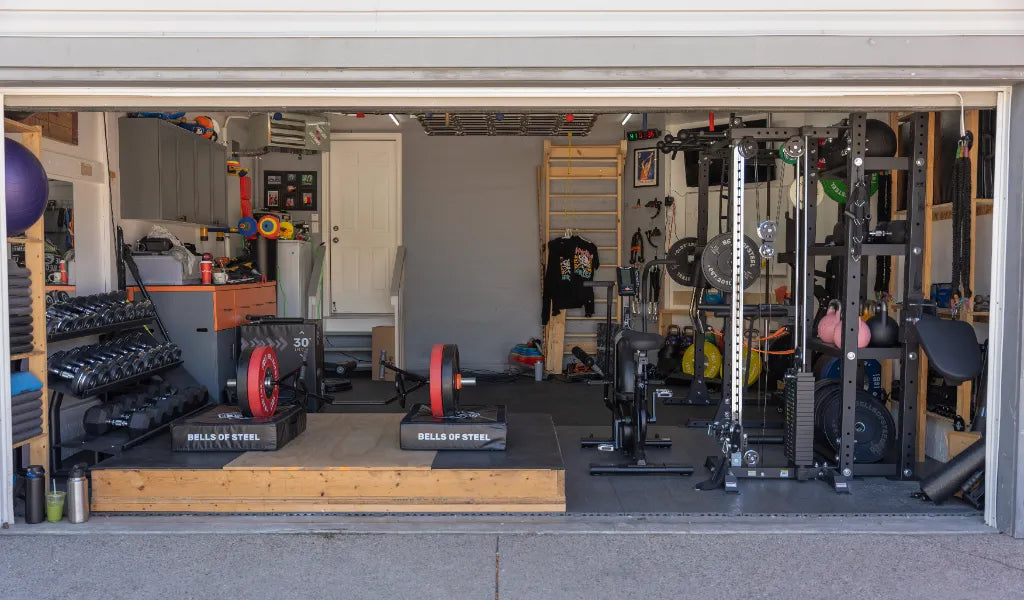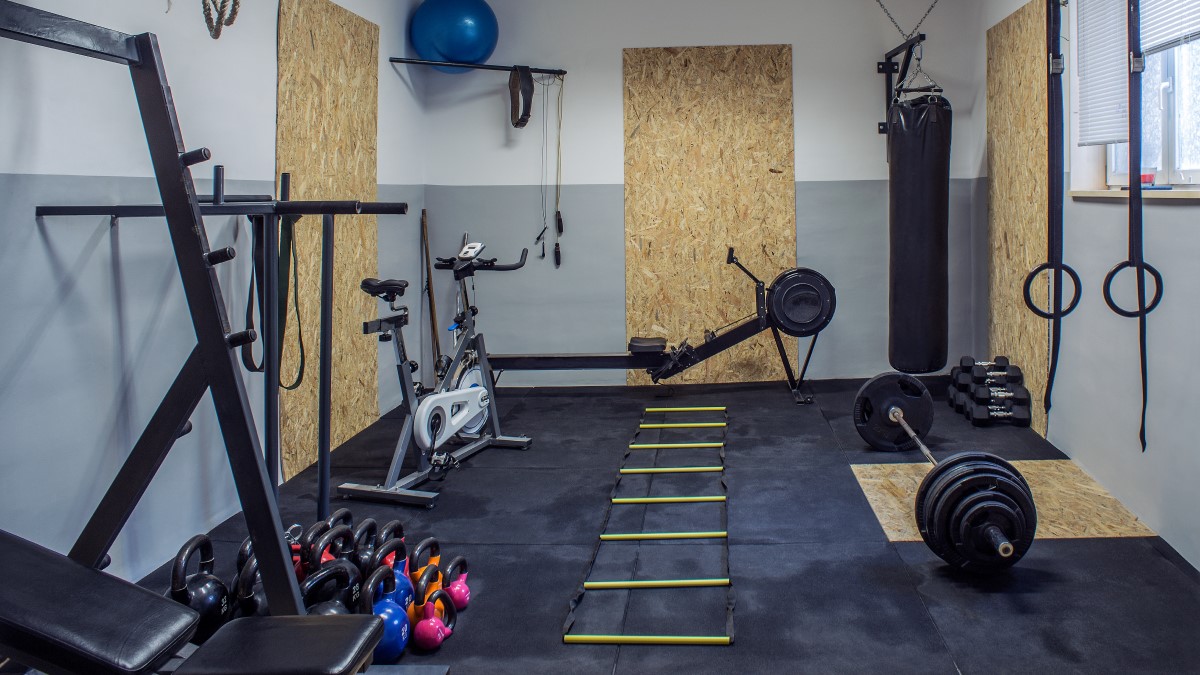Are you dreaming of a home gym but unsure about how much space you really need? Imagine waking up, skipping the commute, and working out in the comfort of your own home.
It sounds ideal, right? But before you start buying equipment, it’s crucial to understand the space requirements. You don’t want to end up squeezing between dumbbells and the sofa, or worse, not being able to use your gear properly. We’ll break down exactly how much room you need for a functional and enjoyable home gym.
Let’s dive into the details so you can create a workout haven that’s perfectly tailored to your needs. Keep reading, and you’ll soon discover that with a little planning, your fitness goals are closer than you think!
Assessing Your Fitness Goals
Creating a home gym starts with understanding your fitness goals. What do you want to achieve? Do you dream of building muscle, losing weight, or improving your endurance? Knowing your goals will guide you in deciding how much space you need. It will also help you choose the right equipment and exercises that align with your aspirations.
Types Of Exercises
Consider the exercises you enjoy and want to include in your routine. If you love yoga, you’ll need a serene space with enough room to stretch out. Weightlifting enthusiasts might require an area for free weights and benches. Cardio lovers may opt for a treadmill or a bike. List the types of exercises that excite you, as this will influence the space requirements for your home gym.
Equipment Requirements
Once you know your exercise preferences, think about the equipment. If you’re keen on resistance training, you’ll need dumbbells, kettlebells, or resistance bands. For cardio, you might want a stationary bike or a rowing machine. Consider multi-functional equipment, like adjustable dumbbells, to save space. What equipment will help you stay motivated and committed to your goals?
Personal experience can be enlightening here. When I set up my home gym, I started with a few dumbbells and a yoga mat, thinking I didn’t need much. But as my goals evolved, so did my equipment list. I realized a treadmill was essential for my cardio sessions, and it required more space than I initially planned. This taught me that your gym space should be adaptable to your changing fitness journey.
Remember, the right space for your home gym doesn’t need to be vast. It’s about creating a functional area that inspires you to stay active. Assess your fitness goals first, and the rest will fall into place. What’s your ultimate fitness goal, and how can your space reflect that?

Credit: bulldoggear.com
Evaluating Available Space
Creating a home gym is an exciting project. It requires careful planning. First, evaluate the available space. This helps in making efficient use of your area. Considerations include room dimensions and flooring. Each plays a crucial role in your setup. A well-planned space enhances workout experience.
Room Dimensions
Start by measuring your room. Note down length, width, and height. This helps in deciding equipment placement. A small room may limit options. For a full gym, aim for 150 square feet. Smaller setups can work in 50 square feet. Always consider ceiling height. Tall equipment needs more vertical space.
Flooring Considerations
Flooring impacts safety and noise. Choose durable materials. Rubber mats are ideal. They absorb impact and reduce noise. Consider interlocking tiles for easy installation. Hardwood floors need protective mats. This prevents damage during workouts. Check for moisture resistance if in a basement. Proper flooring enhances comfort and longevity.
Choosing Essential Equipment
Creating a home gym requires thoughtful planning. Consider the space available before selecting essential equipment. Ensure the area accommodates your fitness needs without feeling cramped.
Creating your own home gym is an exciting journey. It offers the convenience of working out whenever you want. But how do you choose the right equipment? Choosing essential equipment is crucial. You want gear that fits your space and meets your fitness goals. Let’s dive into some practical options.Free Weights Vs Machines
Do you enjoy lifting weights? Free weights like dumbbells and kettlebells can be a great start. They are versatile and take up less space. You can easily store them in a corner when not in use. Machines, on the other hand, might offer more guidance and stability. If you’re new to strength training, they can help you maintain proper form. But remember, machines typically require more space. Consider how much room you have before choosing. Think about your workout style. Do you prefer the flexibility of free weights or the structure of machines?Cardio Equipment Options
Cardio is essential for heart health. A treadmill or stationary bike can offer a solid workout. These options are perfect if you love running or cycling. But, they can be bulky. If space is tight, look at foldable versions. Ellipticals and rowing machines are alternatives worth considering. They provide low-impact workouts, which are gentle on your joints. They also vary in size, so check dimensions before buying. Have you thought about compact options like jump ropes or step platforms? They offer an effective cardio workout without taking up much space. What cardio equipment suits your lifestyle and space? Choose wisely to make the most of your home gym.
Credit: bellsofsteel.us
Designing Your Gym Layout
Determining space for a home gym requires considering equipment size and room layout. Smaller rooms need compact gear. Large areas allow for more variety. Prioritize essential equipment for a functional setup.
Designing your home gym layout requires careful planning. Thoughtful arrangement maximizes space and enhances workout efficiency. Consider the size and shape of the room. Tailor your gym design to suit your fitness goals. Create a welcoming environment that motivates you to exercise regularly.Optimal Equipment Arrangement
Arrange gym equipment efficiently to utilize the available space. Place larger machines like treadmills against walls. This opens up the center of the room. Designate an area for free weights. Ensure there is enough space around them. This allows safe and comfortable usage. Keep essential gear within easy reach. Store smaller items in accessible locations.Space-saving Solutions
Choose compact equipment to save space. Foldable treadmills and adjustable dumbbells are great options. Consider wall-mounted storage solutions. They free up floor space. Use vertical racks for weights and mats. Mirrors enhance the sense of space. They make the room feel larger and brighter. Optimize lighting to create a welcoming atmosphere.Budget Considerations
Creating a home gym requires careful budget considerations. You want a space that meets your fitness goals without breaking the bank. Understanding the financial aspects will help you make informed decisions. Let’s explore the key budget factors.
Cost Of Equipment
Equipment costs vary based on your fitness needs. Basic items like dumbbells and resistance bands are affordable. Larger machines like treadmills and rowing machines cost more. Consider starting with essential items. This helps manage costs effectively. Check online for deals and second-hand options. You might find quality equipment at lower prices.
Space Renovation Expenses
Transforming a room into a gym may require renovations. Painting walls, adding mirrors, or installing rubber flooring adds to the cost. Evaluate the condition of your chosen space. Sometimes, a fresh coat of paint is all it needs. Flooring often requires special attention. Rubber mats protect floors and reduce noise. Consider the size of your space for accurate estimates.
Safety And Accessibility
Creating a safe and accessible home gym requires thoughtful space planning. Ensure clear paths and room for movement. Prioritize safety by allowing enough space for equipment use and emergency exits.
Creating a home gym is a dream for many fitness enthusiasts. But have you considered how safety and accessibility play a critical role in your setup? Your gym should not only be functional but also safe and easy to use. Imagine working out in a space where you can easily move around without worrying about tripping or breathing discomfort. Let’s dive into how you can ensure your home gym is both safe and accessible.Ensuring Proper Ventilation
Proper ventilation is key to maintaining a healthy workout environment. Your space should allow for fresh air circulation to prevent stuffiness and bad odors. Think about installing a small exhaust fan or keeping a window open. This simple step can make your workout more enjoyable and less tiring. Is your workout space in a basement or a garage? If so, consider investing in a portable air purifier to keep the air clean and fresh.Safe Flooring Choices
Flooring is crucial for both safety and comfort during your workouts. Opt for non-slip surfaces to prevent accidents. Rubber mats are a popular choice because they provide good grip and cushioning. They also protect your floors from heavy equipment. If you’ve ever slipped while doing lunges, you know how important flooring is. A safe floor can boost your confidence and improve your performance. Safety and accessibility should be top priorities in your home gym. What changes can you make to create a space where you feel secure and motivated to achieve your fitness goals?Maximizing Small Spaces
Creating a home gym in a small space can be a rewarding challenge. You might think you need a large room, but with clever planning, even a compact area can become a fitness haven. The key is to maximize the space you have, using smart strategies to ensure you have everything you need for a great workout. You’ll be amazed at what you can achieve without sacrificing comfort or functionality.
Multi-functional Equipment
Investing in multi-functional equipment is a game-changer for small home gyms. Think of gear that serves multiple purposes like adjustable benches or compact weight systems. These tools allow you to perform a variety of exercises without needing extra space for individual equipment. Imagine having a bench that doubles as a squat rack—suddenly, your workout options expand dramatically without cluttering your area.
Don’t overlook simple items like resistance bands, which are perfect for strength training and take up virtually no space. You can easily store them in a drawer after a workout. They offer versatility for exercises ranging from squats to arm curls, making them ideal for small spaces.
Vertical Storage Solutions
Utilizing vertical storage is crucial in maximizing your gym area. Wall-mounted racks can hold weights, resistance bands, or yoga mats, keeping your floor clear for exercise. Think of your walls as potential storage goldmines. Hooks and shelves can transform them into functional storage spaces.
Consider installing wall bars for storing dumbbells or kettlebells. Not only do these keep your equipment organized, but they also add a sleek, professional look to your gym. Vertical storage solutions ensure that your workout space remains tidy and accessible.
As you maximize your small space, ask yourself: What creative solutions can you implement today? You’ll find that with a bit of ingenuity, your home gym can be both efficient and inspiring, even in the coziest of corners.

Credit: www.hygym.co.uk
Incorporating Personal Touches
Creating a home gym offers more than just a space for workouts. It’s an opportunity to design an environment that reflects your personality. Adding personal touches makes your gym inviting and motivating. Consider decor, ambiance, and technology to enhance your home gym experience.
Decor And Ambiance
Decor sets the mood for your home gym. Choose colors that energize or calm you. Wall art can inspire and keep you motivated. Mirrors are practical and make the space feel larger. Soft lighting creates a relaxing atmosphere for yoga or stretching. Plants add a touch of nature and improve air quality. Select flooring that suits your workout needs and style. Rubber mats or hardwood are popular choices.
Technology Integration
Technology can elevate your workout experience. Install a sound system for music or guided workouts. A wall-mounted TV is great for fitness videos or virtual classes. Fitness apps on tablets or phones offer workout plans and tracking. Smart mirrors provide real-time feedback and instruction. Wi-Fi connectivity ensures seamless streaming and access to online resources. Keep your devices charged with strategically placed outlets or charging stations.
Frequently Asked Questions
Is 10×10 Big Enough For A Home Gym?
A 10×10 space can work for a home gym with careful equipment selection. Focus on compact gear like resistance bands, dumbbells, or a foldable treadmill. Ensure enough room for movement and exercises. This setup suits basic workouts but might feel cramped for multiple users or larger equipment.
What Is The Minimum Area For A Home Gym?
A minimum area of 150 square feet is ideal for a home gym. This space allows room for basic equipment and exercises. Ensure adequate ventilation and lighting for a comfortable workout environment. Consider space-saving equipment to maximize efficiency in smaller areas.
What Size Is Needed For A Home Gym?
A home gym typically needs at least 150-200 square feet. This space accommodates basic equipment like a treadmill, weights, and a bench. Consider ceiling height for exercises and equipment setup. More space enhances comfort and allows for additional machines and workout variety.
How Much Square Footage Do You Need For A Home Gym?
A home gym typically requires 150 to 250 square feet. Space depends on equipment and workout preferences. Compact setups need less room, while extensive setups require more. Consider ceiling height for equipment like treadmills and ellipticals. Ensure enough space for movement and safety.
Plan layout efficiently to maximize your gym area.
Conclusion
Creating a home gym doesn’t require a vast space. Assess your available area and choose equipment wisely. Prioritize versatile gear to maximize your workout options. Consider your fitness goals and plan accordingly. Even a small corner can serve as an effective workout zone.
Ensure there’s enough room for movement and safety. A clutter-free space enhances motivation and focus. Remember, consistency is key to your fitness journey. With thoughtful planning, you can enjoy a functional home gym. Start small, and expand as needed. Fitness is about progress, not perfection.
Enjoy your workouts in the comfort of your home.



